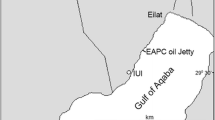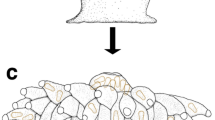Abstract
Octocorals are characterized by pinnate tentacles and internal sclerites. Their feeding ability is determined by the morphological features of the polyps. Capture of their food by these corals is also affected by the flexibility of the colony, which in turn is determined by the features of the sclerites. We studied the morphological features of two azooxanthellate octocorals, Dendronephthya hemprichi and D. sinaiensis, whose depth distribution partially overlaps at Eilat (northern Red Sea). Following Gause’s Law, such coexistence is considered to be possible if each species is adapted to utilize different food items. In order to examine this Law, the features of the polyps of the two species and their sclerites were studied. Each side of their tentacles displays 11–13 pinnules, which are longer at the tentacles’ distal end compared to its median section and proximal end, with the distal pinnules of D. sinaiensis being longer than those of D. hemprichi. At the proximal end of the tentacles of D. sinaiensis, the pinnules emerge perpendicularly, unlike in D. hemprichi, where they emerge from the lateral sides; the distance between the rows of pinnules is, therefore, shorter for the former. These findings imply that the filtered phytoplankton by the two species may differ in size. Their sclerites also differ in size and shape, and therefore the expansion and contraction abilities of their polyps also differ, and may thus affect their respective feeding abilities. The findings indicate that D. hemprichi and D. sinaiensis are adapted to utilize different food items, and therefore support Gause’s Law and explain the coexistence of the two species.





Similar content being viewed by others
References
Barki Y (1992) Population ecology and genetic characteristics of the soft coral Dendronephthya in the northern Gulf of Eilat, Red Sea. MSc Thesis, Tel-Aviv University, Israel (in Hebrew with English summary)
Bayer FM (1973) Colonial organization in octocorals. In: Brodman RS, Cheetman AH, Oliver WA Jr (eds) Animal colonies development and function through time. Dowden, Hutchinson and Ross,Pennsylvenia, pp 69–93
Bayer FM, Grasshoff M, Verseveldt J (1983) Illustrated trilingual glossary of morphological and anatomical terms applied to Octocorallia. Brill, Leiden
Benayahu Y (1985) Faunistic composition and patterns in the distribution of soft corals (Octocorallia, Alcyonacea) along the coral reefs of Sinai peninsula. Proceedings of the 5th International Coral Reefs Congress Tahiti 6:255–260
Benayahu Y, Loya Y (1977) Space partitioning by stony corals soft corals and benthic algae on coral reefs of northern Gulf of Eilat (Red-Sea). Helgol wiss Meeresunters 30:362–382
Benayahu Y, Loya Y (1981) Competition for space among coral-reef sessile organisms at Eilat, Red-Sea. Bull Mar Sci 31:514–522
Brucet S, Boix D, López-Flores R, Badosa A, Quintana XD (2006) Size and species diversity of zooplankton communities in fluctuating Mediterranean salt marshes. Estuar Coast Shelf Sci 67:424–432
Dahan M, Benayahu Y (1997a) Reproduction of Dendronephthya hemprichi (Cnidaria: Octocorallia): year-round spawning in an azooxanthellate soft coral. Mar Biol 129:573–579
Dahan M, Benayahu Y (1997b) Clonal propagation by the azooxanthellate octocoral Dendronephthya hemprichi. Coral Reefs 16:5–12
Dahan M, Benayahu Y (1998) Embryogenesis, planulae longetivity, and competence in octocoral Dendronephthya hemprichi. Invertebr Biol 117:271–280
Dai CF, Lin MC (1993) The effect of flow on feeding of three gorgonians from southern Taiwan. J Exp Mar Biol Ecol 173:57–69
Fabricius KE, Benayahu Y, Genin A (1995a) Herbivory in asymbiotic soft corals. Science 268:90–92
Fabricius KE, Genin A, Benayahu Y (1995b) Flow-dependent herbivory and growth in zooxanthellae-free soft corals. Limnol Oceanogr 40:1290–1301
Fabricius K, Alderslade P (2001) Soft corals and sea fans: a comprehensive guide to the tropical shallow water genera of the central-west Pacific, the Indian Ocean and the Red Sea. Australian Institute of Marine Science and the Museum and Art Gallery of the Northern Territory
Gause GF (1934) The struggle for existence. Williams and Wilkins, Baltimore
Goldberg W (1973) The ecology of the coral-octocoral communities off the southeast Florida coast: geomorphology, species composition and zonation. Bull Mar Sci 24:465–488
Gravel D, Canham CD, Beaudet M, Messier C (2006) Reconciling niche and neutrality: the continuum hypothesis. Ecol Lett 9:399–409
Grossowicz M (2008) Niche partitioning among three azooxanthellate soft coral species in Eilat (northern Red Sea). MSc Thesis, Tel-Aviv University, Israel (in Hebrew with English summary)
Jørgensen CB (1955) Quantitative aspects of filter feeding in invertebrate. Biol Rev 30:391–453
Kinzie RAIII (1973) The zonation of West Indian Gorgonians. Bull Mar Sci 23:93–155
Lasker HR, Gottfried MD, Coffroth MA (1983) Effects of depth on feeding capabilities of two octocorals. Mar Biol 73:73–78
Lewis JC, von Wallis E (1991) The function of surface sclerites in gorgonians (Coelenterata, Octocorallia). Biol Bull 181:275–288
Lin MC, Dai CF (1996) Drag, morphology and mechanical properties of three species of octocorals. J Exp Mar Biol Ecol 201:13–22
Lindell D, Post AF (1995) Ultraphytoplankton succession is triggered by deep winter mixing in the Gulf of Aqaba (Eilat), Red sea. Limnol Oceanogr 40:1130–1141
McFadden SC, Sánchez JA, France SC (2010) Molecular phylogenetic insights into the evolution of Octocorallia: a review. Integr Comp Biol 50:389–410
Menden-Deuer S, Lessard EJ, Satterberg J (2001) Effect of preservation on dinoflagellate and diatom cell volume and consequences for carbon biomass predictions. Mar Ecol Prog Ser 222:41–50
Mikami OK, Kohda M, Kawata M (2004) A new hypothesis for species coexistence: male–male repulsion promotes coexistence of competing species. Popul Ecol 46:213–217
Perkol-Finkel S, Benayahu Y (2004) Community structure of stony and soft corals on vertical unplanned artificial reefs in Eilat (Red Sea): comparison to natural reefs. Coral Reefs 23:195–205
Perkol-Finkel S, Benayahu Y (2005) Recruitment of benthic organisms onto a planed artificial reef: shift in community structure one decade post-deployment. Mar Environ Res 59:79–99
Post AF, Dedej Z, Gottlieb R, Li H, Thomas D, El-Absawi M, El-Naggar A, El-Gharabawi M, Sommer U (2002) Spatial and temporal distribution of Trichodesmium spp. in the stratified Gulf of Aqaba, Red Sea. Mar Ecol Prog Ser 239:241–250
Reiss Z, Hottinger L (1984) The Gulf of Aqaba: ecological micropaleontology. Springer, New York
Roney HC, Booth GM, Cox PA (2009) Competitive exclusion of Cyanobacterial species in the Great Salt Lake. Extremophiles 13:355–361
Rubenstein DI, Koehl MAR (1977) The mechanisms of filter feeding: some theoretical considerations. Am Nat 111:981–994
Rutman J, Fishelson L (1969) Food composition and feeding behavior of shallow-water crinoids at Eilat (Red Sea). Mar Biol 3:46–57
Sebens KP, Johnson AS (1991) Effect of water movement on prey capture and distribution of reef coral. Hydrobiologia 216(217):247–248
Sponaugle S, LaBarbera M (1991) Drag-induced deformation - a functional feeding strategy in 2 species of gorgonians. J Exp Mar Biol Ecol 148:121–134
Vasconcelos P, Gaspar MB, Castro M (2006) Development of indices for nonsacrificial sexing of imposex-affected Hexaplex (Trunculariopsis) Trunculus (Gastropoda: Muricidae). J Molluscan Stud 72:285–294
Verseveldt J (1965) Report on the Octocoralia (Stolonifera and Alcyonacea) of the Israel South Red Sea Expedition 1962, with notes on other collections from the Red Sea. Sea Fish Res Stn Haifa Bull 14:27–47
Verseveldt J (1970) Report on some Octocorallia (Alcyonacea) from the northern Red Sea. Isr J Zool 19:209–229
Vogel S (1981) Life in moving fluids, the physical biology of low. Princeton University Press, New Jersey
Wang ZL, Zhang DY, Wang G (2005) Does spatial structure facilitate coexistence of identical competitors? Ecol Model 181:17–23
Witman JD, Dayton PK (2001) Rocky subtidal communities. In: MD Bartness, SD Gaines, ME Hay (eds) Marine community ecology. Sinauer, Sunderland, MA, pp 339–366
Yacobovitch T, Weis VM, Benayahu Y (2003) Development and survivorship of zooxanthellate and azooxanthellate primary polyps of the soft coral Heteroxenia fuscescens: laboratory and field comparisons. Mar Biol 142:1055–1063
Acknowledgments
We thank the Interuniversity Institute for Marine Sciences at Eilat (IUI) for the use of facilities and assistance. We thank the Eilat-Ashqelon Pipe Line Company (EAPC) for cooperation and the Israel Nature and National Parks Protection Authority for issuing the collection permit. We acknowledge Y. Delaria for SEM work, A. Shlagman for curatorial help, N. Paz for editorial assistance, and V. Wexsler for graphic work. We thank C. Lueter, Museum fuer Naturkunde, Berlin, for placing type material at our disposal. The study was in part supported by the Israel Cohen Chair in Environmental Zoology (Y. B.) and a grant from The Porter School of Environmental Studies (PSES) at Tel Aviv University. The article constitutes part of on MSc thesis in Ecology and Environmental Quality at Tel-Aviv University submitted by M. Grossowicz.
Author information
Authors and Affiliations
Corresponding author
Rights and permissions
About this article
Cite this article
Grossowicz, M., Benayahu, Y. Differential morphological features of two Dendronephthya soft coral species suggest differences in feeding niches. Mar Biodiv 42, 65–72 (2012). https://doi.org/10.1007/s12526-011-0093-0
Received:
Revised:
Accepted:
Published:
Issue Date:
DOI: https://doi.org/10.1007/s12526-011-0093-0




